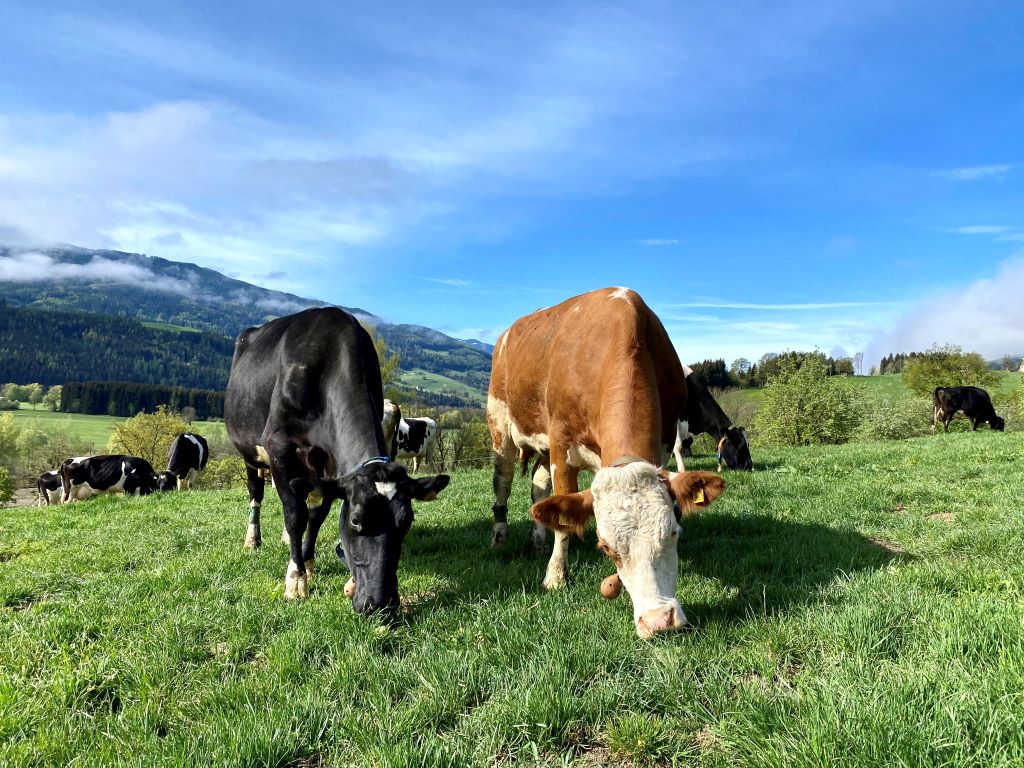In a two-year research project at the Bio-Institute of the HBLFA Raumberg-Gumpenstein, short-grass pasture was compared with an intensive paddock pasture system. The individual animal and area performance, changes in the plant population and also the lying and rumination behavior of the cows were extensively recorded.
Two year trial
At the start of grazing, a total of 24 autumn/winter calving dairy cows were evenly allocated to the two full-pasture experimental groups. The grazing trial period extends from mid-April to the end of August. During the experimental period, all test cows received, in addition to pasture feed, only 1.0 kg of fresh mass concentrate per cow per day (0.5 kg/meal) and supplemented with minerals in the stable. There were no extreme weather conditions in both test years or pasture seasons; the annual average rainfall was slightly below the 30-year average, so there were no longer dry phases during the pasture test period.
Different growth heights
The short grass pasture (KRW) was grazed at an average pasture growth height of 5.5 cm (measured with the pasturemeter). The intensively used paddock pasture areas (KOP) were divided into three-day paddocks and day paddocks were created within the paddocks, which were gradually expanded over three days. Over the entire test period, an average shoot growth height of 8.9 cm and a shoot growth height of 5.8 cm were found in the intensive paddock group. During the paddock grazing period in the first and second grazing year, the average pasture rest periods between two rotations for the respective first day-part paddock were 15 and 20 days, respectively.
Interesting results
In the paddock system, the proportion of grasses in the plant population was on average around 10% higher than in short-grass pasture. These effects were found in both English ryegrass and meadow bluegrass. In contrast, in the paddock system the proportions of herbs, panicles and gaps were significantly lower on average. With regard to root mass, a decrease in root mass was found in the first 5 cm of the soil horizon over the course of the grazing season in short grass pasture; this effect was less pronounced in the intensive paddock pasture group. Tendency pasture system effects were also evident in the root horizon of 10 to 15 cm, whereby the root mass over the course of the grazing season was also deeper in short-grass pasture than in the paddock system. These effects also correspond to data from the literature and previous tests at the site. In addition to the ground shading and the more favorable “microclimate” close to the ground, this also explains the slightly longer endurance and yield level of paddock pastures in dry conditions.
Feed quality at a high level
With regard to the nutrient contents of the pasture forage samples examined, there were no average differences between pasture system groups. The average net energy content of the pasture feed in both pasture systems was at a very high level of 6.7 MJ NEL/kg DM. One explanation for this is that the paddock pastures were also used very young (growth height 8.9 cm).
Milk production does not differ
Both in terms of average individual milk production (KOP: 19.5 kg energy-corrected milk production; KRW: 20.8 kg ECM) and in milk area production (KOP: 59.1 kg ECM/ha and day; KRW: 59.8 kg ECM/ha and day) there were no significant group differences, numerically the short grass pasture was higher. The animals in the paddock group had lower milk protein and urea contents as well as live weight and BCS than those in the short-grass pasture group. No significant pasture group effects were found with regard to the daily lying time of the cows, which was on average 8.8 hours. The daily rumination time was 7.8 hours in intensive paddock grazing. For short grass pasture this was slightly shorter by 4% at 7.5 hours.
In summary , it can be said that the pasture system influenced both the plant population and root development. However, these effects did not affect the nutrient content of the feed used very young. With regard to milk individual animal and area performance, there were no significant pasture system effects under the given experimental conditions (no dry phases, cows on full pasture during autumn/winter calving).













